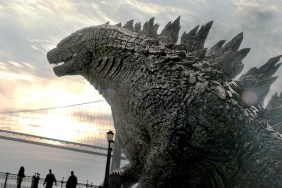I’m noticing more patterns. Also Godzilla has changed from evil to good.
Welcome back to my summer-long kaiju super-fest The Summer of Godzilla, my latest and most ambitious installment in The Series Project to date. I am now 15 films down, which is nearly halfway through the 31-film Godzilla cycle, and I’m still having a great time overall, even though there have been a few outright stinkers along the way. Indeed, this week I’ll be writing about one of the worst of the Godzilla movies, which is crazy and impossible to follow, and features a giant Ultraman-like robot for good measure.
To orient you: This week, I will be writing about the 11th through the 14th Godzilla films, which were some of the final films in the Toho or Showa era. The Showa era was the first cycle of Godzilla films, and lasted 15 chapters, ending in 1975 with Terror of Mechagodzilla. In 1984, the series rebooted itself with The Return of Godzilla, and continued in a new continuity for seven films, before ending in 1995. This second era is referred to as the Heisei era. Then in 1999, the series rebooted a second time with yet another new continuity, this time called the Millennium era, and lasted another six chapters. As of this week, I am one film away from the end of the first era.
And, as I said, I’m noticing a few patterns. The Godzilla films, while all bonkers kid-friendly monster vs. monster brawls, shift wildly and randomly in tone from film to film. Some definitely skew toward younger kids, while others tend to be reaching for a more broad audience with slicker production values and a more somber tone. The budgets rise and fall from film to film, and you can never be sure if you’re going to get a slick one or a shabby one. A fluffy one or a preachy one. I have noticed, however, that the “serious” films can be distinguished by the number of nighttime monster fights, while the more kiddie-fied ones have fights that take place exclusively during the day. The high budget ones will have both.
We’ve also reached a point in the series where the monsters are getting more and more bizarre. Gabara from All Monsters Attack was a weird green-skinned dog ape thing, and kind of stood out from the Godzilla monster canon as one of the more oddball monsters. Yes, there is a canon of Godzilla monsters. This week, we’ll see monsters like Gigan and Megalon, and you’ll be scratching your head at the sight of a hook-handed buzzsaw bird thing and a giant drill-handed beetle with a magic horn. If you have ever wondered where Pokémon came from, watch some of these Godzilla movies from the 1970s, and you’ll start to get a better idea.
You can also tell which of the Godzilla movies are better based on how long you have to wait before you see a monster. While I do love my monsters (I’m even a little bit fond of the weirder ones), the better movies tend to wait before they unleash any. The old formula still works best: Intrepid reporters discover some sort of plot, and as they unravel it, they are exposed to evil government secrets or, more often, evil secretive aliens, with a plan to take over the world in a monster-based fashion. It won’t be until about 30 minutes in that monsters will start appearing. The final 30 minutes of these films are going to be nothing but monster mayhem. None of the films yet has been over 96 minutes. The worse films in the series deviate from this formula considerably (as in All Monsters Attack, or this week’s Godzilla vs. Megalon), and also feature little kids as protagonists. All Monsters Attack, you may recall, took place almost entirely inside a little boy’s mind. Also, the monsters tend to show up right away, catering directly to little kids with short attention spans.
This week, we’re going to start with the first “message” Godzilla film since the first one. Let’s look at
Godzilla vs. Hedorah
a.k.a. Godzilla vs. The Smog Monster


Release Date: 24th July, 1971
New Monster: Hedorah
Description: Acid-spitting, smog-breathing amorphous mound of living sewage
Origin: Extraterrestrial dust merged with human pollution to form a sludge monster.
Destruction: Godzilla reflects his radiation breath off of an electro-weapon, drying out Hedorah. Then he rips out Hedorah’s eyes and inner organs and does it again. Then he stomps on the pieces.
Actor(s): Haruo Nakajima (Godzilla), Kengo Nakayama (Hedorah)
This is the first monster since Godzilla himself in the 1954 original that has a direct political corollary. Godzilla was, as we all know, a direct symbol for the atomic bomb (seeing as he was created by nuclear radiation) and the damage and fears that The Bomb created in Japan. Hedorah is an environmental warning. If we don’t stop polluting, our garbage will come back to kill us. In the form of a mindless 100-foot-tall tower of quivering glop. In addition to some bizarro animated interstitials (depicting Hedorah eating factories and laying waste to the environment), the film also ends with a mistranslated phrase “PERHAPS ANOTHER ONE?” (clearly a more sophisticated way of saying “THE END?”) implying that, if we are not careful, another Hedorah will rise up from the polluted seas and eat our cars and melt our skin with acid.

These political messages don’t make the film any more sophisticated, however, as it’s about as subtle as an episode of “Captain Planet and the Planeteers.” Indeed, what with the animated segments and some acid-inspired dance numbers (!), Godzilla vs. Hedorah is downright psychedelic.
It should be noted as well that Godzilla himself is now less of a terrible monster and more of a national icon, called in to stop other giant monster menaces. Godzilla’s city-stomping days are over, and he’ll always have his showdown in an open field or mountainscape. Godzilla has turned from a symbol of destruction into a benevolent monster police force. Godzilla still cannot be controlled, but he has decided to be a good monster rather than a bad one. Much of it may stem from Godzilla’s own territorial nature. He can share Monster Island with other benevolent monsters, but there is now a growing cast of evil monsters constantly lurking about. Godzilla will leave Monster Island to kill off these new destructive interlopers. Godzilla is a tool for peace. How are we to read this? Either that Godzilla’s free will overcame his destructive origins, or that we are thinking of The Bomb in a more forgiving light. Sure, it has the power to kill everything on the planet (save few cockroaches), but if used right, it’s a badass policing tool. I think I like the former interpretation much better.

Anyway, Hedorah first appears out of the seas as a massive tadpole-shaped blob with big red eyes. It leaves a gooey silt on our heroes (a scientist played by Akira Yamauchi, a nondescript sidekick played by Hiroyuki Kawase and a little kid played by Toshie Kimura). Our scientist buddy is burned in the face with acid, and becomes resolute in finding out just what that giant tadpole thing was. There are many scenes of test tubes and microscopes.
They eventually find out that it’s a Hedorah (I don’t know where the name came from), and that it can change shape, and that it lives by sucking up pollution and smog and becoming larger. It also emits clouds of acid that melt and kill anyone nearby. As it becomes stronger over the course of the film, Hedorah also reveals that it can turn into a flying UFO-shaped slime patty, and also that it can fire a death ray out of its head (!). Hedorah creeps into dance clubs, and crawls onto land to eat cars and melt buildings. Hedorah is insidious. When Godzilla appears to do battle with the sludge, he is stymied by his amorphous body, and finds himself punching through gooey skin without doing damage. Maybe the implication here is that pollution is more destructive than The Bomb, and even a Bomb cannot destroy our proclivity to pollute. Or maybe it’s a film about a giant nuclear amphibian punching holes in a giant mound of living sewage.

Eventually our heroes discover that Hedorah can be dried out. Hedorah is gray and silvery in this film – kind of mineral and silty – but I got the implication that it’s actually made of human feces. Which is very very disgusting. Godzilla is fighting a poo monster. Anyway, the military constructs a pair of giant reflective electric panels that have the ability to electrify Hedorah dry. The only thing that can power it, however, is Godzilla breath. Luckily, Godzilla figures out how the panels work, and does his thing, frying Hedorah, then ripping it apart, then frying it again, then stomping on the remains. Godzilla hates pollution. Give a hoot, stomp pollution into the ground after you rip out its eyes. There is also an amusing scene wherein Godzilla grabs Hedorah, lifts his tail up between his legs, and lets fly with his nuclear breath, effectively rocketing himself through the air. Sadly, Godzilla will not propel himself in this fashion in any future film.
The monster action is fun (the mechanics of a 100-foot slime beast are fully explored), but man this film is weird. Hedorah is a bizarre preachy symbol, and the tone is half goofy and half totally earnest. I recommend this film, but only if you’ve already seen multiple Godzilla films to prime you first. Don’t start with Hedorah.
The next film is pretty good. Let’s look at…






